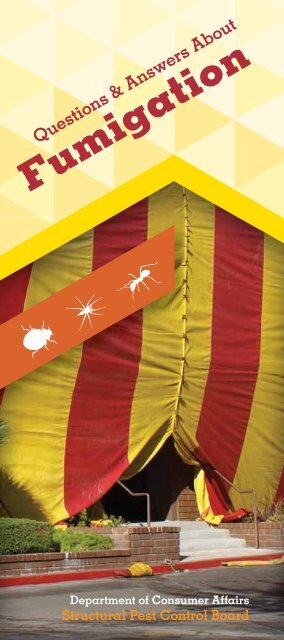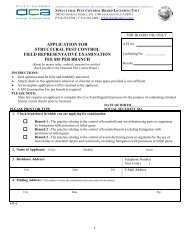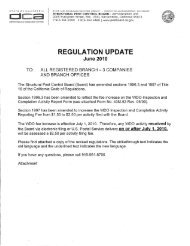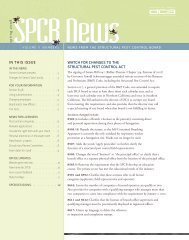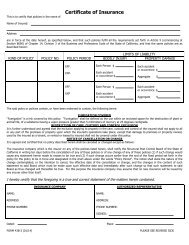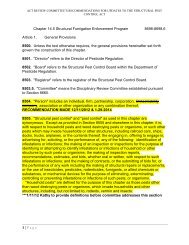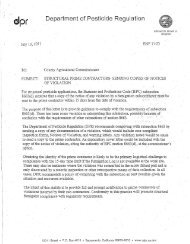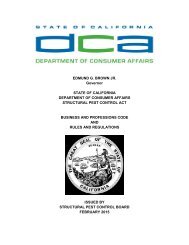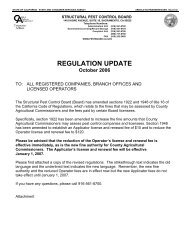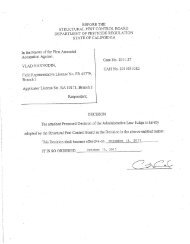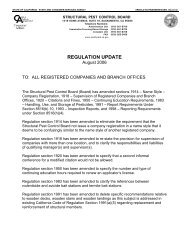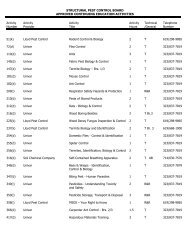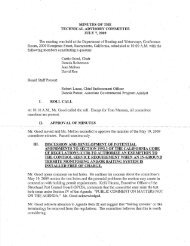Fumigation - Structural Pest Control Board - State of California
Fumigation - Structural Pest Control Board - State of California
Fumigation - Structural Pest Control Board - State of California
You also want an ePaper? Increase the reach of your titles
YUMPU automatically turns print PDFs into web optimized ePapers that Google loves.
Questions & Answers About<br />
<strong>Fumigation</strong><br />
Department <strong>of</strong> Consumer Affairs<br />
<strong>Structural</strong> <strong>Pest</strong> <strong>Control</strong> <strong>Board</strong>
The <strong>Structural</strong> <strong>Pest</strong> <strong>Control</strong> <strong>Board</strong> (SPCB)<br />
licenses and regulates businesses and<br />
individuals for pest control. Licensees must<br />
meet minimum qualifications and levels <strong>of</strong><br />
competency to provide safe and effective<br />
services to the public. Licenses can be verified<br />
online at www.pestboard.ca.gov.
What is fumigation?<br />
<strong>Fumigation</strong> is a method <strong>of</strong> using a<br />
lethal gas to exterminate pests within<br />
an enclosed space. There are two<br />
fumigation methods used. One is to seal<br />
the structure with plastic, tape, or other<br />
materials, and the other is to enclose the<br />
structure in a tent <strong>of</strong> vinyl-coated nylon<br />
tarpaulins.
How can I tell if my house has been<br />
fumigated?<br />
Since 1961, the law requires that, when a<br />
fumigation is complete, the fumigator must post<br />
a sign with the name <strong>of</strong> the licensee, the date<br />
<strong>of</strong> the fumigation, and the fumigant used. The<br />
sign must be posted either in the attic or in the<br />
subarea <strong>of</strong> a house, such as a garage. The sign<br />
must remain permanently attached.<br />
What must be done before a house is<br />
fumigated?<br />
All people, pets, and plants must be removed<br />
from the structure before fumigation. This<br />
includes fish and seeds or bulbs intended for<br />
planting. Medicines, feed, and food not sealed<br />
in metal, glass, or highly resistant containers<br />
must be removed from the structure or sealed<br />
in protective bags as recommended by the<br />
fumigant manufacturer. Ask your fumigator any<br />
questions you have about the process and<br />
preparations.
What information about my house<br />
should I give my structural pest<br />
control company before fumigation?<br />
Your structural pest control company is<br />
required to ask you about the presence <strong>of</strong><br />
any construction elements, conduits, drains, or<br />
vacuum systems that could allow the fumigant to<br />
pass from your home to adjacent or adjoining<br />
structures.<br />
How long does a fumigation take?<br />
A fumigation can take from six hours to one<br />
week depending on the type <strong>of</strong> infestation,<br />
dosage, temperature, size <strong>of</strong> the structure, and<br />
other factors.<br />
What does the fumigant smell like?<br />
<strong>Structural</strong> fumigants are odorless. Because<br />
<strong>of</strong> that, fumigators are required to release a<br />
warning agent such as chloropicrin (tear gas)<br />
within the structure when the fumigation begins<br />
and throughout the fumigation process.<br />
All people,<br />
pets, and<br />
plants must be<br />
removed from the<br />
structure before<br />
fumigation.
When drywood termites or woodboring<br />
beetles are found, does<br />
the structure always have to be<br />
fumigated?<br />
No. <strong>Fumigation</strong> is not always required for<br />
treating drywood termites and wood-boring<br />
beetles. <strong>Fumigation</strong> is an all-encompassing<br />
treatment in which the gases permeate the entire<br />
structure, eradicating both visible infestations<br />
and termites that are otherwise inaccessible.<br />
If only a small area is infested, local<br />
applications may be used. The inspector will<br />
decide which treatment is necessary. You should<br />
be aware that the localized treatments will not<br />
eradicate hidden infestations elsewhere in the<br />
building.<br />
Will fumigation eliminate all the<br />
termites and pests in the structure?<br />
No. Subterranean termites require separate<br />
treatments to create a barrier between the<br />
structure and their nest in the ground. Under<br />
ideal conditions, the target pest will be dead or<br />
obviously dying by the end <strong>of</strong> the fumigation.<br />
Drywood termites can remain alive as long as<br />
a week after a lethal dose <strong>of</strong> a fumigant. Lethal<br />
doses vary for different pests, depending on the<br />
fumigant used.<br />
It is possible for household pests (such as<br />
spiders or cockroaches) to survive a fumigation.
NOTE:<br />
Reinfestations <strong>of</strong> the target pest could occur<br />
following a fumigation. Drywood termites and<br />
some wood-destroying beetles produce small<br />
pellets or dusts that remain in the tunnels after<br />
the insects are killed. You may continue to<br />
notice these signs after a fumigation. This does<br />
not necessarily mean the fumigation failed.<br />
If you have any questions about the success<br />
<strong>of</strong> your treatment, contact your pest control<br />
company. Since fumigants have no residual<br />
effect, other household pests can reinfect the<br />
structure after a fumigation.
How are occupants <strong>of</strong> a structure told<br />
that a fumigation will be done?<br />
Before a structural pest control company applies<br />
a fumigant, it must have in its possession an<br />
occupant fumigation notice signed by the<br />
occupants <strong>of</strong> a structure or their designated<br />
agent. The fumigation notice must state the pest<br />
to be controlled, the proposed pesticide or<br />
pesticides (including their active ingredients),<br />
and the caution statement. This form must state<br />
that a lethal gas will be used in the building on<br />
specified dates and that it is unsafe to return to<br />
the building until a notice <strong>of</strong> re-entry is posted by<br />
the licensee in charge <strong>of</strong> the fumigation.<br />
The residents <strong>of</strong> the structure and the owner<br />
should receive a copy <strong>of</strong> the occupant<br />
fumigation notice.
How can a consumer find out which<br />
fumigants were used on their<br />
property?<br />
Before a structural pest control operator applies<br />
a fumigant, he or she must inform the owner or<br />
owner’s agent and the tenants <strong>of</strong> the fumigants<br />
proposed for use and their active ingredients.<br />
Also, this notification must alert the occupants to<br />
call their physician or poison control center and<br />
the pest control company <strong>of</strong> a reaction after<br />
fumigation.<br />
The form should advise consumers to call if<br />
anyone entering the structure experiences<br />
symptoms <strong>of</strong> dizziness, nausea, reduced<br />
awareness, slowed movement, garbled speech,<br />
or difficulty breathing within 24 hours and give<br />
any other symptoms <strong>of</strong> overexposure.<br />
The name <strong>of</strong> the fumigant used will be entered<br />
on the notice <strong>of</strong> re-entry that will be posted on<br />
the door. This is in addition to the fumigation<br />
tag, which has the name <strong>of</strong> the pest control<br />
company, date <strong>of</strong> the fumigation, and the<br />
name <strong>of</strong> the fumigant used. These tags will be<br />
permanently affixed in the subarea or attic.
Who can enter a structure while it is<br />
being fumigated?<br />
Chemicals used in fumigation are lethal!<br />
Exposure to fumigants in a structure being<br />
fumigated, even for a few minutes, will result in<br />
death or serious injury. Absolutely NO ONE<br />
can enter a structure until it has been certified<br />
safe for re-entry by the licensee in charge <strong>of</strong> the<br />
fumigation. Warning signs are posted in plainly<br />
visible locations on or in the immediate vicinity<br />
<strong>of</strong> all entrances.<br />
To ensure that even the owner or tenant cannot<br />
re-enter a structure, the company is required to<br />
put a secondary lock on all outside<br />
doors that only the company<br />
can open. These locks can<br />
be any device such as<br />
padlock, keyway lock,<br />
or deadbolts which will<br />
prevent opening by<br />
anyone but<br />
the licensee<br />
in charge.
How will I know when it is safe to<br />
enter a home that has just been<br />
fumigated?<br />
The fumigator is required to post a re-entry<br />
notice on the property when the structure is<br />
judged safe for occupancy. The notice states<br />
the building is safe for re-entry, and gives the<br />
date and time the building was released, the<br />
name <strong>of</strong> the structural pest control company<br />
issuing the notice, and its license and phone<br />
numbers.<br />
What should I do if I feel sick after a<br />
fumigation?<br />
If, within 24 hours after application, you<br />
experience headaches, dizziness, nausea,<br />
watery eyes, coughing, nose or throat irritation,<br />
shortness <strong>of</strong> breath, double vision, unusual<br />
drowsiness, weakness, or tremors, leave the<br />
fumigated structure and immediately contact<br />
your doctor, poison control center, the structural<br />
pest control company, and the <strong>Structural</strong> <strong>Pest</strong><br />
<strong>Control</strong> <strong>Board</strong> (SPCB) to report the incident.<br />
Your poison control center can be reached at<br />
(800) 222-1222. The hotline is answered<br />
24 hours a day, and interpreters are available.
Can a homeowner contract directly<br />
with a fumigation company?<br />
Yes, a homeowner can contract with a Branch 1<br />
fumigation company to fumigate by providing a<br />
copy <strong>of</strong> an inspection report which identifies a<br />
wood-destroying pest that can be eradicated by<br />
fumigation. The Branch 1 company will issue a<br />
certification <strong>of</strong> fumigation to the homeowner and<br />
to the pest control company that performed the<br />
inspection within five days <strong>of</strong> the fumigation.<br />
The pest control company that performed the<br />
inspection will attach the fumigation certification<br />
to any reinspection report, notice <strong>of</strong> work<br />
completed, or certification which it issues.<br />
Are fumigations safe?<br />
<strong>Fumigation</strong>s are highly regulated by the <strong>State</strong> <strong>of</strong><br />
<strong>California</strong>. To perform fumigations, companies<br />
must be registered with SPCB. <strong>Pest</strong> control<br />
companies may also be required to notify local<br />
fire departments before a fumigation takes place.<br />
The <strong>California</strong> Department <strong>of</strong> <strong>Pest</strong>icide Regulation<br />
registers all fumigants used in the <strong>State</strong> and<br />
oversees local pesticide use enforcement by<br />
agricultural commissioners in each <strong>of</strong> the <strong>State</strong>’s<br />
58 counties.<br />
If you have any questions about the safety <strong>of</strong><br />
fumigants, chemicals, or pesticides, you may<br />
call your local county agricultural commissioner.<br />
You can find the phone number and be directly<br />
connected by calling (877) 378-5463 or<br />
87-<strong>Pest</strong>Line.
Are there alternative methods to<br />
fumigation?<br />
There are several alternatives for localized<br />
chemical treatments. There are, however, only<br />
two methods for whole-house eradication <strong>of</strong><br />
drywood termites: fumigation and whole-house<br />
heat treatment. Other methods such as electro<br />
gun, microwave, and freezing with liquid<br />
nitrogen are local or spot treatments designed to<br />
eradicate termites in a specific area.<br />
These methods are not intended for whole house<br />
eradication and therefore are NOT alternatives<br />
to fumigation. The University <strong>of</strong> <strong>California</strong>,<br />
Berkeley, conducted a study for SPCB on these<br />
methods. A free, condensed version <strong>of</strong> the<br />
study is available on SPCB’s Web site,<br />
www.pestboard.ca.gov/howdoi/research.shtml.<br />
How can I find out if a company<br />
is properly licensed and in good<br />
standing?<br />
You can call SPCB’s Complaint Unit at<br />
(800) 737-8188 to find out if a company is<br />
properly registered or if an individual holds a<br />
valid license. You can also check the licence<br />
on SPCB’s Web site at www.pestboard.ca.gov.<br />
A history <strong>of</strong> complaints against licensees during<br />
the past two years is also available online.
What can I do if I am not satisfied<br />
with the services <strong>of</strong> a structural pest<br />
control company?<br />
If you are unhappy with the service, call the<br />
company and discuss your concerns. If the<br />
company does not resolve the problem to<br />
your satisfaction, you can contact SPCB for<br />
assistance. You can also download a<br />
complaint form from the SPCB Web site<br />
at www.pestboard.ca.gov.
<strong>Structural</strong> <strong>Pest</strong> <strong>Control</strong> <strong>Board</strong><br />
2005 Evergreen Street, Suite 1500<br />
Sacramento, CA 95815<br />
www.pestboard.ca.gov<br />
(916) 561-8708<br />
(800) 737-8188<br />
pestboard@dca.ca.gov<br />
13_170 (12/2013)


